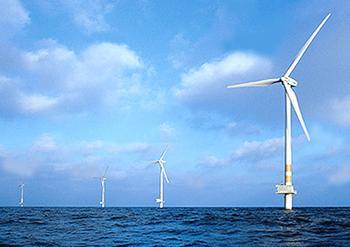
Japan will bid farewell to the era of nuclear energy and usher in the era of renewable energy. The Japanese government has planned to build an offshore wind power station on the original site of the Fukushima nuclear power plant in July this year. After the completion of the new power plant will surpass the existing global power station. In addition, the government wants to invest in large-scale construction, not only adopting a cost-effective construction method, but also making a comprehensive consideration of the safety performance of the equipment.
Japan plans to build the world's largest offshore wind power station in July 2013. This measure indicates that Japan will bid farewell to nuclear energy and usher in the era of renewable energy.
According to this plan, as of 2020, Fukushima will build a platform 16 kilometers from the coast and build a total of 143 wind turbines on this basis. This is the location of the Fukushima Daiichi Nuclear Reactor, which was hit by an earthquake and tsunami in March 2011. The disaster occupied the headlines of major newspapers.
The construction of this wind power station capable of producing 1 billion watts of electricity is part of Japan's post-disaster reconstruction. After the tsunami, 54 nuclear reactors in Japan were closed and only two of them returned to service. Therefore, the government plans to increase renewable energy.
This project is part of the Fukushima plan and it seeks to achieve the goal of self-sufficiency in energy supply by relying solely on renewable energy in 2040. This area also initiated the construction of the "National Solar Park". This wind power station will surpass the Greater Gabbard power station on the coast of Suffolk, England. The Greater Gabbard power station is currently the world’s largest power station with 140 turbines and a power output of 5.4 million watts. This privilege will soon be won by the London Array power station at the Thames Estuary. It will be operational by the end of this year and will have 175 turbines capable of producing 630 million watts in total. But they will all be the defeated men of Fukushima.
Large-scale construction
The first step in the Fukushima construction project will be the construction of a turbine with a capacity of two million watts, a substation and laying of submarine cables. This turbine will be up to 200 meters. If completed, the construction of the remaining turbines will depend on the trial fundraising situation.
In order to eliminate the need to fix turbines on the sea floor, they decided to build the turbines on buoyancy steel. This steel frame will be fastened by the mooring line to the 200-meter-thick Japanese continental shelf and will remain stable under the ballast.
Once the plant is fully operational, it will supply electricity to the powerful grid that once connected the two nuclear power plants in Fukushima to reduce transmission consumption.
Takeshi Ishihara, a project manager from the University of Tokyo, insists that frequent earthquakes in that area will not affect the construction of turbines. His research team used computer simulations and water tank experiments to verify the safety of their designed turbines in extreme conditions such as earthquakes, tsunami events, and typhoons. "All the extremes are taken into account when designing," he said.
The impact of this facility on fisheries that have been devastated by nuclear accidents is also a controversial topic. Ishihara insisted that it is possible to build a power station into an "ocean ranch" that can attract fish. Although some local residents are opposed to this project, Ishihara still confidently stated that he has won their recognition. “This is a difficult task, but it can be resolved within this month,” he said. “This is a very important project and Fukushima will never be able to use nuclear energy again.”

 Japan will bid farewell to the era of nuclear energy and usher in the era of renewable energy. The Japanese government has planned to build an offshore wind power station on the original site of the Fukushima nuclear power plant in July this year. After the completion of the new power plant will surpass the existing global power station. In addition, the government wants to invest in large-scale construction, not only adopting a cost-effective construction method, but also making a comprehensive consideration of the safety performance of the equipment.
Japan will bid farewell to the era of nuclear energy and usher in the era of renewable energy. The Japanese government has planned to build an offshore wind power station on the original site of the Fukushima nuclear power plant in July this year. After the completion of the new power plant will surpass the existing global power station. In addition, the government wants to invest in large-scale construction, not only adopting a cost-effective construction method, but also making a comprehensive consideration of the safety performance of the equipment. 


